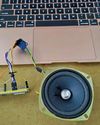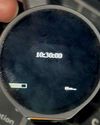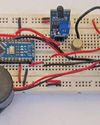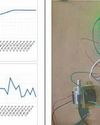
An ESP32 camera (cam) can take pictures at 2MB per second rate and transmit them up to 200 metres using a small antenna on 2.4GHz. But when it teams up with an internet-enabled network it can do artificial intelligence (AI) related work as well.
In this project the ESP32 cam takes and sends the pictures to a remote computer that is connected to the internet, pulls the specified AI model, and analyses the object (model) to identify it. It then sends the object’s identity back to the ESP32 cam, which then executes the object-specific command entrusted to it.
When the detection computer is on, the ESP32 cam is all vigilant and ready for action. Once the model is loaded (identified), an active internet connection is no longer required. However, the computer needs to remain on all the time.
The ESP32 cam also reproduces the live feed from the ESP32 camera. The IP address is set as fixed type (192.168.43.11), which can be changed as per requirement.
The ESP32 continuously draws the image boundary over the image. If it finds two images, it draws two boundaries, and so on. Its confidence level can be set from 0 to 100%.
Image Resolution, MirrorImage, Flash (on 100% switch on the in-built LED), Quality, Brightness, and Contrast (see Fig. 6) can be changed. However, on increasing image resolution from 320×240 to 1600×1200 the system become extremely slow. It is better to leave the control at the default level and change only if necessary. Author’s prototype is shown in Fig. 1.
Circuit and working
This story is from the {{IssueName}} edition of {{MagazineName}}.
Start your 7-day Magzter GOLD free trial to access thousands of curated premium stories, and 9,000+ magazines and newspapers.
Already a subscriber ? Sign In
This story is from the {{IssueName}} edition of {{MagazineName}}.
Start your 7-day Magzter GOLD free trial to access thousands of curated premium stories, and 9,000+ magazines and newspapers.
Already a subscriber? Sign In

STK435 IC-Based STEREO AMPLIFIER
This stereo AF amplifier uses the STK435 IC, a highly popular choice due to its simplicity.

A SEWER DRAIN SHIELD For Smart Cities
Drainage systems are vital for storm water management but often transport pollutants, especially plastics, to rivers and oceans, harming ecosystems.

ESP32 SPEECH FUNCTION: Text To Speech
Speech capability in technology primarily has two dimensions: text to speech (TTS) and speech to text (STT). This device focuses on TTS.

World's Smallest Programable INDUSPHONE DESIGN
This is the second part of designing the world’s smallest phone, where the UI is integrated with the basic functions of the phone.

FLAME-SENSING FIRE ALARM Using An Arduino Nano
Fire safety alarms are crucial in both residential and industrial environments.

loT-Based Distribution Transformer CONDITION MONITORING SYSTEM
The proposed IoT-based distribution transformer condition monitoring system enables real-time monitoring of distribution transformers, identifying such deviations as overload conditions and overheating.

Wi-Fi 6 AND Wi-Fi 7 Powering The Next Wave of Smart Connectivity
Wi-Fi 6 leads with faster data rates and reduced latency while upcoming Wi-Fi 7's backward compatibility will facilitate gradual upgrades from Wi-Fi 6, easing transitions. However, advanced features like multi-link operation (MLO) and ultra-low latency may command a premium, making Wi-Fi 7 suited for high-end applications.

CHARGE FORWARD: High-Voltage Batteries And MSMEs Can Fuel INDIA'S EV REVOLUTION
A nuanced explanation of low- and high-voltage EV batteries by Dr Gokhale, Vice President for Battery Technology at JSW Energy, illuminates their advancements and influence. The essential role of MSMEs and academia in developing a strong EV ecosystem emerges, marking their significance for India's push towards self-reliance in this innovative field.

"MILES TO GO Before I Sleep"
A teacher illuminates the path to success through the light of knowledge, yet some teachers extend that light to society through their contributions and research. Known as the architect of the modern M3 electronic voting machine (EVM) and the voter verifiable paper audit trail (VVPAT) that transformed India's democratic process, Prof. (Dr) Rajat Moona's journey began in the modest town of Bareilly. Here is his story, as recounted to and written by EFY's Yashasvini Razdan.

STARTUPS & INNOVATORS
1 One Charger To Charge All Your Devices | 2 Harnessing AI Technology For Efficient Pest Management | 3 Wireless Light-Based Communication With Velmenni's Technology